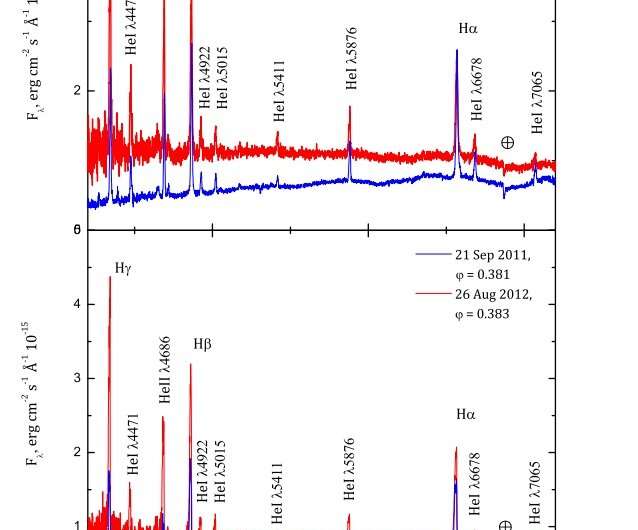January 5, 2023 report
This article has been reviewed according to Science X's editorial process and policies. Editors have highlighted the following attributes while ensuring the content's credibility:
fact-checked
peer-reviewed publication
trusted source
proofread
Observers explore the eclipsing polar BS Tri

Russian astronomers have performed spectroscopic and photometric observations of a peculiar eclipsing polar known as BS Tri. Result of this observational campaign, presented in a paper published December 23 on arXiv.org, shed more light on the properties of BS Tri, especially on the accretion process taking place in this system.
CVs are close binary star systems comprising of a white dwarf and a low mass main-sequence star (most often a red dwarf). They irregularly increase in brightness by a large factor, then drop back down to a quiescent state. Polars are a subclass of cataclysmic variables distinguished from other CVs by the presence of a very strong magnetic field in their white dwarfs.
BS Tri was first detected as a bright X-ray source by the ROSAT space observatory. Subsequent observations of this source revealed the Balmer series hydrogen and neutral helium emission lines in its spectra, typical of cataclysmic variables, and also deep eclipses in its light curve. The magnetic nature of BS Tri was confirmed later, which was crucial to its classification as a polar.
BS Tri consists of a white dwarf with a mass of 0.75 solar masses and a red dwarf companion with an estimated mass of about 0.16 solar masses. The system has an orbital period of approximately 96.3 minutes. However, although several studies of this polar have been conducted, many of its parameters still remain unknown.
That is why a group of astronomers led by Alexander I. Kolbin of the Special Astrophysical Observatory (SAO) in Russia decided to analyze spectroscopic and photometric observations of BS Tri. They investigated a set of BS Tri spectra acquired with SAO's 6-m BTA telescope and photometric data obtained with the ZTE 125-cm telescope and the Zeiss-600 60-cm telescope, both located at the South Astronomical Station of the Moscow State University.
The photometric data shows variations in the shape of the light curves of BS Tri caused by different contributions of the accretion stream to the integral radiation of the system. However, no strong variations in the average brightness were recorded for the entire observation period of BS Tri.
Based on the radial velocity curves of the irradiated hemisphere of the red dwarf, the astronomers managed to refine some parameters of the system. For instance, they found that both components of BS Tri are less massive than previously estimated—0.6 and 0.12 solar masses, for the primary and secondary stars, respectively. The orbital inclination of the system was measured to be 85 degrees.
Furthermore, the study found that the spectra of BS Tri showcase broad cyclotron harmonics that change their position as the white dwarf spins. By modeling the cyclotron spectra, the researchers calculated that magnetic field strength in the accretion spot is about 22.7 MG, and that the average spot temperature is at a level of 10 keV.
The scientists also found that the spectra of BS Tri contain Zeeman components of hydrogen-alpha line, appearing simultaneously with cyclotron harmonics and are formed at magnetic field strength of 21.5 MG.
"A possible explanation for this phenomenon is the presence of a cool halo around the accretion spot, whose signs are found in some other polars," the authors of the paper explained.
More information: Alexander I Kolbin et al, On accretion in the eclipsing polar BS Tri, Monthly Notices of the Royal Astronomical Society (2021). DOI: 10.1093/mnras/stab3676. On ArXiv: arxiv.org/abs/2212.12464
Journal information: Monthly Notices of the Royal Astronomical Society
© 2023 Science X Network




















